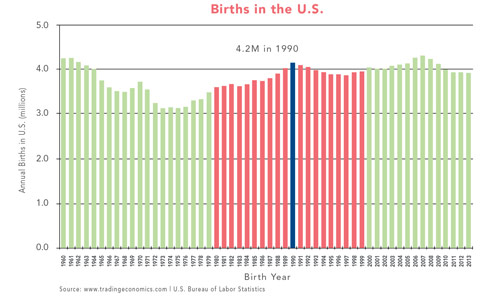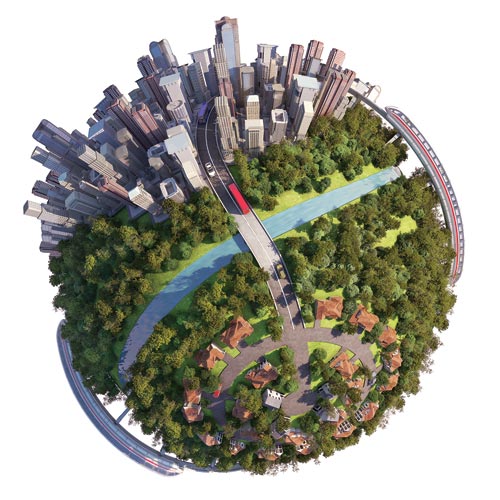Too often, companies that have not updated their real estate portfolio or strategy in the past decade will find that their prior tactics are simply no longer working in the race to attract talent. After years of building sprawling campuses in suburban markets, companies are now questioning whether existing real estate footprints are “urban” enough to attract today’s workers. Over the past few years, we have seen the trend of corporations moving corporate headquarters as well as groups charged with innovation into more urban hubs, primarily as a move to attract young talent. After all, this is the latest catchphrase…the “urbanization” of America.
But should we move to make this a long-term strategy? Is there something brewing behind this trend where all young, educated, selfie-snapping millennials are sipping on lattes as they plug away at their tablets and smartphones in a renovated warehouse turned coffee shop in a previously blighted neighborhood in a large city? In order to answer this question, we need to dive a bit further into the reasons behind the tight labor market and the numbers before we can understand the concept of urbanization and predict how it will shape the future of site location decisions.
The Labor Participation Rate
As stated, the most recent unemployment figures peg our national unemployment at a very low 4.6 percent, meaning we are almost at full employment. Those who want to poke holes in the economic progress touted by the Obama administration are quick to point out that unemployment rates don’t include individuals who simply stop looking for work because they become disenfranchised by the system or their prospects. If you look at the numbers further, we actually will see that both theories are actually correct, depending on the data sets utilized.
If you go back to the data collected since 1950, the U.S. Bureau of Labor Statistics reports that the average labor participation rate (LPR) is 63 percent. The most recent figure from November of 2016 indicates that the current LPR is 62.7 percent, which is down slightly from previous months (meaning this hasn’t been impacted by holiday hiring). This would seem to indicate that our LPR is at its historical average; therefore, we can’t really point the finger at those who are able to work but choose not to, and who simply fall out of the unemployment figures because of their unwillingness to search for an employment opportunity.

Birth Rates
The analysis of the tight labor market would not be complete without a full understanding of the labor force gap that was created when the baby-boomers started to retire. So why is it that we talk so much about trying to attract those that were born after 1980? Are these kids so much smarter than those born in the 70s that every business can’t survive without them? While the answer is no, the reality of the situation is that attracting millennials in the workforce is a necessity, but it is based upon numbers, not talent. Low birth rates in the late 1960s and through the 1970s created a gap when baby-boomers started to retire, as there simply weren’t enough Gen Xers to fill their places in the workforce. The analysis of the tight labor market would not be complete without a full understanding of the labor force gap that was created when the baby-boomers started to retire.
The picture becomes very clear when you look at the total U.S. labor force. Based upon data supplied by the U.S. Bureau of Labor Statistics, the U.S. labor force grew an average of 1.77 percent each year from 1978 to 2001. We have chosen 2001 because this is the year that the first millennials (born in 1980) turned 21 years old and presumably started entering the workforce after college. If you continued that growth trend, the labor force population would have been considerably larger than the actual figures through November of 2016, showing how negatively the labor force was impacted once the baby-boomers started to retire. The actual labor force rate increase from 2001 to 2016 was only 0.7 percent despite the huge number of millennials that joined the workforce. This was due to the fact that the millennial hires could not keep pace with the retirements of the baby-boomers. With such a large drop off in the labor force, it is clear why the unemployment rate has fallen so low, and why there is a shortage of qualified workers to choose from.
So Why the “Urbanization”?
Because of the factors discussed above, young people have hit the job market at a time when companies are hungry to court them. There are several factors that have led this group to want to reside in major cities. First, young professionals have always enjoyed the company of other like-minded individuals, and they can find like-minded individuals in greater numbers in urban centers. Secondly, they are able to move away from their family and friends because technology now gives them easier access to the people they want to stay connected with, even if they are far away. Additionally, at an age before having children, they can spend most of their disposable income on themselves, which helps with higher rents found in urban markets. To counter this, the millennial group has gravitated to some of the areas of cities that once were considered blighted, but with good access to the city center, typically by public transportation. This has created gentrification in these areas, causing significant issues with the relocation of individuals in the lower socioeconomic brackets who previously inhabited those neighborhoods. This young talent, huddled together in these urban areas, has created a near-term opportunity for those in charge of site selection decisions to locate in these areas to tap into the labor pipeline that exists.

According to data from economist Jed Kolko, as reported in The Washington Post (April 1, 2016) the millennial population in dense urban centers is declining. Contrary to what popular thinking has lead us to believe, this large group of talented individuals is starting to reverse the urbanization trend. In fairness, this will most likely have dramatic impacts on the suburban communities that millennials choose to move into, demanding a more urban center feel with walkable/bike-able amenities. That said, the larger house and yard, better for family life, might be calling their names.
So before you lay all your chips down on that long-term city center lease, just take into consideration what your labor force’s preferences may be over the next five to 10 years, as it could be dramatically different than what it is today.



